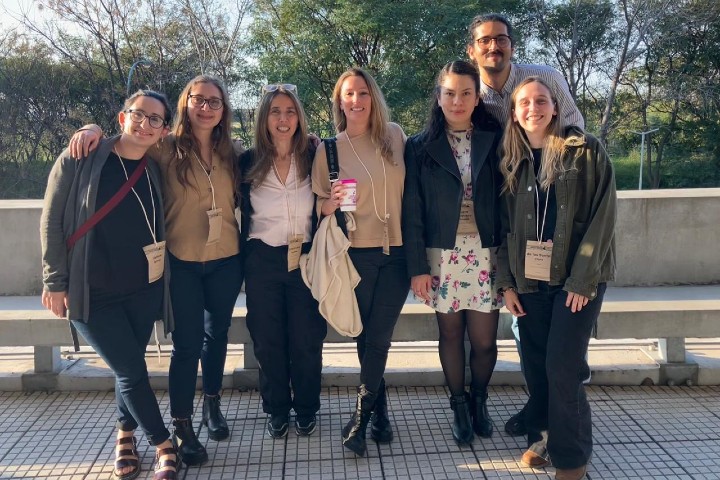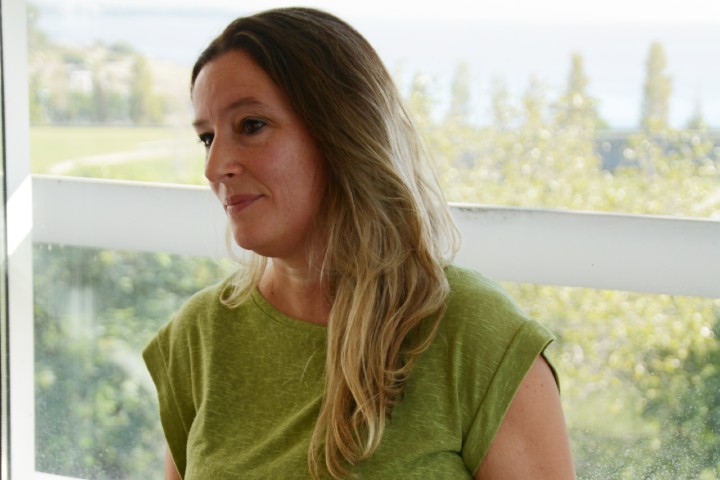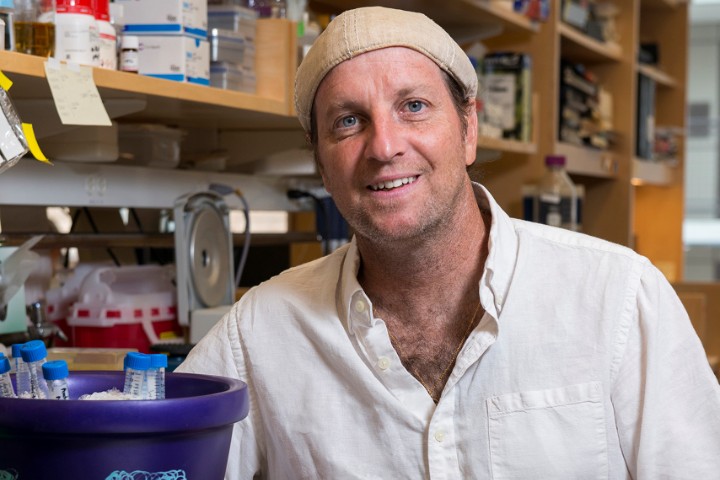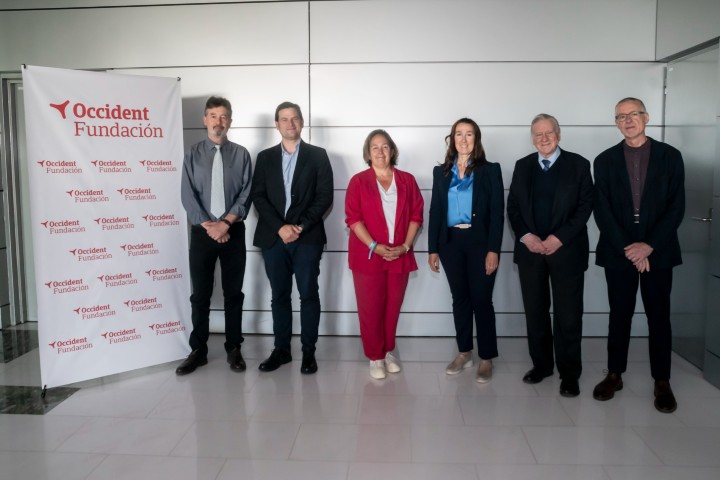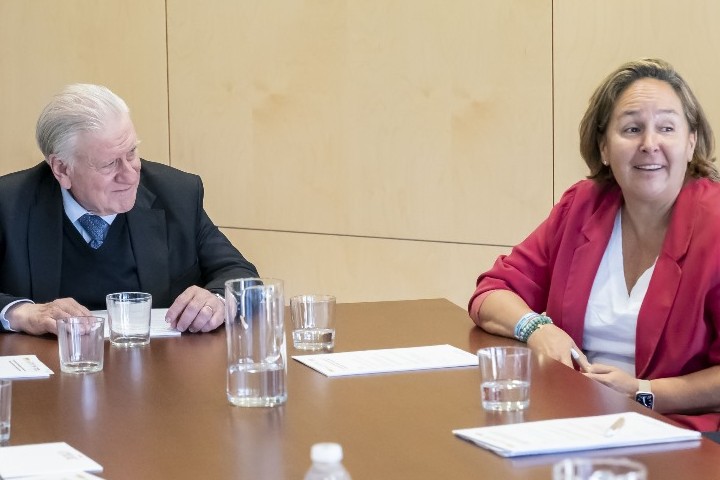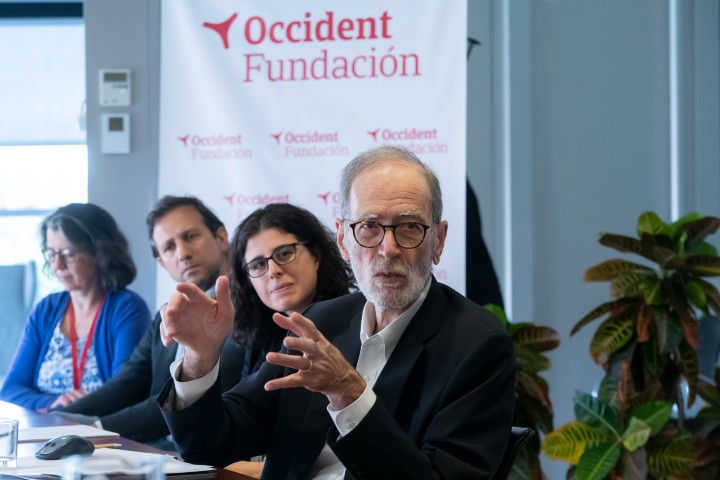
Dr Fuster, Dr Ibáñez and our CNIC visiting researchers
Meeting with Dr Valentín Fuster, Dr Borja Ibáñez and our visiting researchers at the CNIC
The Fundación Occident Visiting Researchers Programme is one of the Foundation's flagship initiatives in the field of research. Under the scheme, a visiting scientist of considerable international standing spends a period at leading research centres in this country. These stays allow the host research group to develop a close relationship with scientists in the visiting researcher's home group and initiate new lines of work based on the generation of new scientific interests.
On 10 May we organised a meeting with scientists Mark Hlatky and Carlos Morillo, our visiting researchers for this year, at the National Centre for Cardiovascular Research (CNIC). We were accompanied by acclaimed cardiologist Dr Valentín Fuster, the current Director of the CNIC and Director of the Mount Sinai Medical Center Cardiovascular Institute in New York, as well as Dr Borja Ibáñez, also a distinguished cardiologist, who is part of the Fuster team and a member of our jury for the annual nutrition and food research awards.
Dr Carlos Morillo is a Professor in the Department of Cardiac Sciences and Senior Clinical Researcher at the University of Calgary's Libin Cardiovascular Institute, Canada. His main research areas involve the design of clinical studies on cardiac arrhythmia, syncope, and treating and managing Chagas disease. Dr Morillo is interested in exploring the role of autonomic cardiac regulation and has published several studies that analyse the role of baroreflexes and sympathetic traffic in different clinical situations such as sudden death, stroke, neurocardiogenic syncope and Chagas cardiomyopathy.
Dr Mark Hlatky is a cardiologist and Professor in the Department of Health Policy at Stanford University School of Medicine. His main fields of research are clinical trials and clinical research methods. His current research focuses on the effects of adverse events during pregnancy on women's long-term cardiovascular health. Dr Hlatky has participated in numerous large randomised multi-centre clinical trials, including studies on coronary revascularisation, the treatment of acute myocardial infarction, hormone therapy to prevent cardiovascular diseases in women, and the treatment of potentially fatal ventricular arrhythmia.
The mission of the CNIC, directed by Dr Valentín Fuster, is to promote cardiovascular research and its application to patients. Its work has earned it recognition as a "Severo Ochoa Centre of Excellence".
Centro Nacional de Investigaciones Oncológicas (National Cancer Research Centre)
Dr Yardena Samuels
Professor Yardena Samuels is a cancer geneticist at the Weizmann Institute of Science, is Director of the Moross Integrated Cancer Center and the Ekard Institute for Cancer Diagnosis Research, and holder of the Knell Family Professorial Chair. Prof. Samuels has received the Pezoller Foundation - EACR Cancer Researcher Award, the Youdim Family Prize for Excellence in Cancer Research, the Michael Bruno Memorial Award and the Sergio Lombroso Award in Cancer Research, is a member of EMBO and President Elect of the European Association for Cancer Research. She worked as a postdoctoral intern in Professor Vogelstein's laboratory at Johns Hopkins University from 2003 to 2006, where she was the first to discover the high frequency of mutations in the PIK3CA gene in human cancers, and then served as Assistant Professor at NIH, before joining the Weizmann Institute in 2012.
Professor Samuels' laboratory seeks to identify and characterise genetic mutations that play a role in the progression of cutaneous melanoma and to identify combinations of target proteins to achieve lasting control of the disease. Her laboratory has identified new causes of melanoma, new oncogenic pathways and the first repertoires of whole exome sequencing for melanoma, leading to five publications in Nature Genetics and a rich genetic database, which was uploaded to the Catalogue of Somatic Mutations in Cancer (COSMIC) database for use by the cancer research community. Her laboratory was part of the TCGA working group that published the genomic classification of cutaneous melanoma and one of its studies paved the way for a clinical study of Phase II.
Tak Mak
Dr Tak Wah Mak is a Canadian medical researcher, geneticist, oncologist and biochemist.
He is currently a senior scientist at the Ontario Cancer Institute; a Professor at the University of Toronto; Director of the Advanced Medical Discovery Institute, University Health Network, Toronto; and a professor at the University of Hong Kong.
He studied Biochemistry and Biophysics at the University of Wisconsin, USA, and obtained his doctorate at the University of Alberta, Canada.
His research interests focus on immune recognition and regulation, as well as cell survival and death in normal and malignant cells.He became widely known for his discovery of the T-cell receptor in 1983 and for his pioneering work in genetics and immunology.
His most recent work includes leading the creation of a series of genetically engineered mice that have proved fundamental to our understanding of intracellular pathways that govern the development and functioning of the immune system, malignant cell transformation, cellular survival, and programmed cell death. His laboratory team are experts in basic research and translational cancer research both in vitro and in vivo. For example, they recently discovered that T-cells produce the prototypical neurotransmitter acetylcholine (ACh), which dilates blood vessels, slowing blood flow enough to facilitate the entry of T cells in infected tissues, ultimately allowing chronic viral infection to be eliminated. More recently, they have determined that IDH mutations are involved in cancer and epigenetic alterations.
Instituto de Astrofísica de Canarias (IAC)
Dr Santi Cassisi is a world-renowned expert in stellar evolution and the main creator and maintainer of the widely used BaSTI (a Bag of Stellar Tracks and Isochrones) stellar model and isochrone library.
In 1993, Cassisi began his career at the Observatoire de Paris in Meudon with a scholarship from the French Government's Ministry of Scientific Research. Subsequently, between 1995 and 1997, he completed his doctoral thesis in Physics at the University of L'Aquila.
Since 1998, Dr Cassisi has been a staff researcher at the INAF - Collurania Astronomical Observatory, also known as the Teramo Observatory, located in the Abruzzo region of central Italy. His main fields of research are theoretical stellar evolution and its application to the study of galactic and extragalactic stellar populations. In this field, he has published some 450 scientific papers, some 290 of which are reference publications, and two monographs for students and researchers.
Dr Vanessa Hill is Research Director at the CNRS, Laboratoire Lagrange, Observatoire de la Côte d'Azur, Nice, France.
Her main field of research is galactic archaeology, focusing on the search for evidence of the formation and evolution of our galaxy in the kinematics and chemistry of its stellar constituents; the search for extremely metal-poor stars (EMPS) in our galaxy and their satellites; and the chemical composition of EMPS to probe the nature of the first stars.
Dr Hill is also interested in studying the evolution of small scale galaxies, such as dwarf galaxies and Magellanic Clouds, as well as the study of chemical abundances on the surface of stars to restrict stellar nucleosynthesis. During her scientific career, she has published 191 peer-reviewed articles, which have been cited about 15,700 times, and has presented 19 guest reviews at international conferences.
